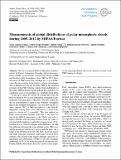Por favor, use este identificador para citar o enlazar a este item:
http://hdl.handle.net/10261/135162COMPARTIR / EXPORTAR:
 SHARE SHARE
 CORE
BASE CORE
BASE
|
|
| Visualizar otros formatos: MARC | Dublin Core | RDF | ORE | MODS | METS | DIDL | DATACITE | |

| Título: | Measurements of global distributions of polar mesospheric clouds during 2005–2012 by MIPAS/Envisat |
Autor: | García Comas, Maia CSIC ORCID ; López-Puertas, Manuel CSIC ORCID; Funke, Bernd CSIC ORCID; Jurado Navarro, Ángel Aythami CSIC; Gardini, A.; Stiller, GP; von Clarmann, T; Hopfner, M | Palabras clave: | Polar mesospheric clouds MIPAS/Envisat |
Fecha de publicación: | 3-jun-2016 | Editor: | Copernicus Publications | Citación: | Atmospheric Chemistry and Physics 16(11): 6701-6719 (2016) | Resumen: | We have analysed MIPAS (Michelson Interferometer for Passive Atmopheric Sounding) infrared measurements of PMCs for the summer seasons in the Northern (NH) and Southern (SH) hemispheres from 2005 to 2012. Measurements of PMCs using this technique are very useful because they are sensitive to the total ice volume and independent of particle size. For the first time, MIPAS has provided coverage of the PMC total ice volume from midlatitudes to the poles. MIPAS measurements indicate the existence of a continuous layer of mesospheric ice, extending from about similar to 81aEuro-km up to about 88-89aEuro-km on average and from the poles to about 50-60A degrees in each hemisphere, increasing in concentration with proximity to the poles. We have found that the ice concentration is larger in the Northern Hemisphere than in the Southern Hemisphere. The ratio between the ice water content (IWC) in both hemispheres is also latitude-dependent, varying from a NHaEuro-a center dot aEuro-SH ratio of 1.4 close to the poles to a factor of 2.1 around 60A degrees. This also implies that PMCs extend to lower latitudes in the NH. A very clear feature of the MIPAS observations is that PMCs tend to be at higher altitudes with increasing distance from the polar region (in both hemispheres), particularly equatorwards of 70A degrees, and that they are about 1aEuro-km higher in the SH than in the NH. The difference between the mean altitude of the PMC layer and the mesopause altitude increases towards the poles and is larger in the NH than in the SH. The PMC layers are denser and wider when the frost-point temperature occurs at lower altitudes. The layered water vapour structure caused by sequestration and sublimation of PMCs is present at latitudes northwards of 70A degrees aEuro-N and more pronounced towards the pole. Finally, MIPAS observations have also shown a clear impact of the migrating diurnal tide on the diurnal variation of the PMC volume ice density. | Versión del editor: | http://dx.doi.org/10.5194/acp-16-6701-2016 | URI: | http://hdl.handle.net/10261/135162 | DOI: | 10.5194/acp-16-6701-2016 | ISSN: | 1680-7316 | E-ISSN: | 1680-7324 |
| Aparece en las colecciones: | (IAA) Artículos |
Ficheros en este ítem:
| Fichero | Descripción | Tamaño | Formato | |
|---|---|---|---|---|
| acp-16-6701-2016.pdf | IAA_2016_acp-16-6701 | 4,46 MB | Adobe PDF |  Visualizar/Abrir |
CORE Recommender
SCOPUSTM
Citations
9
checked on 11-abr-2024
WEB OF SCIENCETM
Citations
7
checked on 24-feb-2024
Page view(s)
237
checked on 19-abr-2024
Download(s)
266
checked on 19-abr-2024
Google ScholarTM
Check
Altmetric
Altmetric
NOTA: Los ítems de Digital.CSIC están protegidos por copyright, con todos los derechos reservados, a menos que se indique lo contrario.
